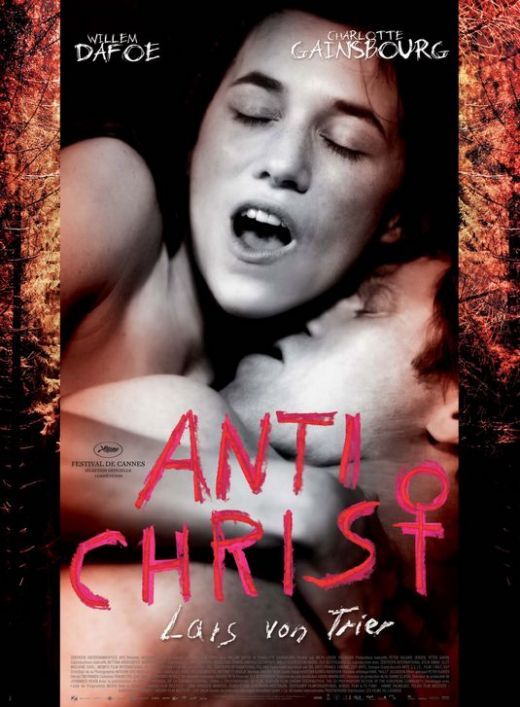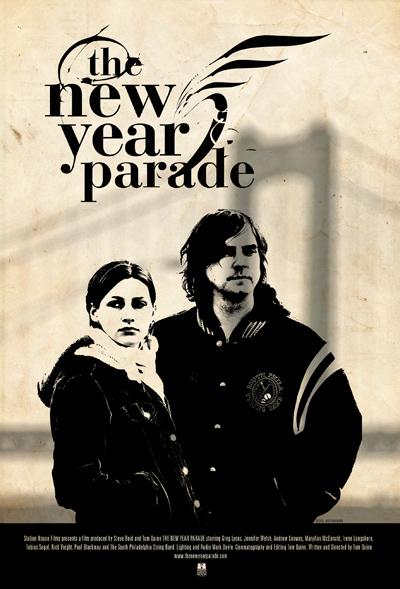
ANTICHRIST (2009, directed by Lars von Trier, 104 minutes, Denmark)
THE NEW YEAR PARADE (2008, directed by Tom Quinn, 84 minutes, U.S.)
 BY DAN BUSKIRK FILM CRITIC Filmmakers will often describe a film heavily inspired by their own experience as a “personal film.” Although Danish filmmaker has never claimed to go mad in a forest cabin it is clear that his latest work Antichrist is also a deeply personal film, not just for von Trier but for its audience as well. It is a work that doesn’t lead you to pre-digested conclusions and instead presents the deep recesses of von Trier’s mind and lets the viewer have their own reactions. Judging from the film’s disdainful reception, it seems that to many if a film that makes you feel dirty and horrible, than the film itself is horrible. But if you want to experience a dark and uncompromised exploration of the recesses of a man’s brain, Antichrist is the must-see film of the year. Then again I’ve never bought into the idea that von Trier is a raving misogynist, a label that has been hung on him ever since he plotted Emily Watson’s Christ-like torture and resurrection in Breaking The Waves. The one-dimensional women that are stalked and killed in slasher films may represent such hatred but surely not the heroines in von Trier’s films, who are exceedingly noble creatures to whom he obviously deeply relates, even as he breaks your heart with their cursed fates. Charlotte Gainsbourg’s character in Antichrist is cut from a different cloth than the female martyrs in his films of the last decade, named only as “She” the character seems more metaphoric than “real” from the get-go.
BY DAN BUSKIRK FILM CRITIC Filmmakers will often describe a film heavily inspired by their own experience as a “personal film.” Although Danish filmmaker has never claimed to go mad in a forest cabin it is clear that his latest work Antichrist is also a deeply personal film, not just for von Trier but for its audience as well. It is a work that doesn’t lead you to pre-digested conclusions and instead presents the deep recesses of von Trier’s mind and lets the viewer have their own reactions. Judging from the film’s disdainful reception, it seems that to many if a film that makes you feel dirty and horrible, than the film itself is horrible. But if you want to experience a dark and uncompromised exploration of the recesses of a man’s brain, Antichrist is the must-see film of the year. Then again I’ve never bought into the idea that von Trier is a raving misogynist, a label that has been hung on him ever since he plotted Emily Watson’s Christ-like torture and resurrection in Breaking The Waves. The one-dimensional women that are stalked and killed in slasher films may represent such hatred but surely not the heroines in von Trier’s films, who are exceedingly noble creatures to whom he obviously deeply relates, even as he breaks your heart with their cursed fates. Charlotte Gainsbourg’s character in Antichrist is cut from a different cloth than the female martyrs in his films of the last decade, named only as “She” the character seems more metaphoric than “real” from the get-go.
Antichrist opens in a beautifully surreal black and white set piece, where Willem Defoe and Charlotte Gainsbourg  (listed in the credits only as “He” and “She”) make love passionately in the shower while their child creeps out of bed and falls out a window, hitting the cement at the same time the couple climaxes, perfectly coupling their sex and guilt. “She” ends up in the hospital for weeks, dazed on drugs and wracked with grief. “He” is a psychologist, who dispenses with medical ethics when he decides to take his wife to an isolated cabin to treat her himself. “Who knows you better than I?” he says, as the camera pulls in to the murky waters and twisted roots that lie beneath the water line of a bouquet at her bedside.
(listed in the credits only as “He” and “She”) make love passionately in the shower while their child creeps out of bed and falls out a window, hitting the cement at the same time the couple climaxes, perfectly coupling their sex and guilt. “She” ends up in the hospital for weeks, dazed on drugs and wracked with grief. “He” is a psychologist, who dispenses with medical ethics when he decides to take his wife to an isolated cabin to treat her himself. “Who knows you better than I?” he says, as the camera pulls in to the murky waters and twisted roots that lie beneath the water line of a bouquet at her bedside.
Driving across a beautifully foreboding landscape much more stylized than von Trier’s Dogma-affiliated work, they travel through a forest named Eden where “He” dispassionately explains that they must get past their grief by facing their fears. It is here that von Trier begins to catalog a number of deeply upsetting fears, from genital mutilation, death, insanity, commitment and the fear of our very nature itself. Audiences seem to be distracted by this close-quarter war the erupts between the man and the woman but is it really two people engaged in this battle? With barely enough fat between their lean frames to make a bar of hotel soap, the androgynous Gainsbourg (a ringer for the young Patti Smith) and the semi-Neanderthal presence of Dafoe make the pair — a psychologist and the academic — seem like warring factions of von Trier’s own mind rather than flesh and blood people. Von Trier has claimed the film was inspired by a bout of crippling depression he experienced, which accounts for the dream logic and unbridled surreality of Antichrist, lingering in the sort of madness that earlier films only touched upon fleetingly.
It’s the sort of dissection of fear and nightmare imagery that only lovers of horror films will make comfort with and pity the poor art house connoisseur who wanders in drawn by Willem Defoe’s name on the marquee. Dafoe is excellent as usual, in another role the takes advantage of his taut physicality and the lizardy-lilt of his voice. Like most von Trier films though, it is the woman with the juicy role. Given permission to dig as deep into her grief as she wants, Gainsbourg delivers a performance that rivals those given by jungle beasts on the Discovery Channel. It’s her performance that the critics who want to write off von Trier’s masterpiece can’t dismiss. It’s a gutsy physical turn that matches von Trier’s brave determination to give us a peak at horrors that lurk within the darkness of our soul, a courageousness to put something on screen that we have not seen before.
– – – – – – – – – – –
From the dreamlike woods of Antichrist to the everyday reality of working class guys dancing in the streets dressed up like giant peacocks. Well everyday if you live in Philadelphia and the day is January first. The Mummers Parade is a  local tradition that goes back hundreds of years and it makes for a colorful setting in The New Year Parade, Tom Quinn’s kitchen sink drama detailing the effects of divorce on a family from the unsurprisingly gritty streets of South Philly.
local tradition that goes back hundreds of years and it makes for a colorful setting in The New Year Parade, Tom Quinn’s kitchen sink drama detailing the effects of divorce on a family from the unsurprisingly gritty streets of South Philly.
This sort of domestic drama is the frequent choice of filmmakers strapped with a tight budget but rarely is it as successfully pulled off as Quinn does here; down to a player, this mostly amateur cast consistently convinces with Quinn’s rough-hewn script. The action centers around Jack (Greg Lyons) a twenty-something guy who is stuck between his parents when his father (Andrew Conway) discovers his mother is having an affair. Jack marches in his father’s low-ranking Mummers outfit though the family friction has him considering jumping ship for the highly ranked Quaker State club. Jack’s teenage sister seems most vulnerable, unable to discuss the parents break-up while also battling with her insensitive boyfriend.
All the dramatic situations you’d expect out of the story are here but it is the unexpected, naturalistic way that the improvised scenes hit their mark is what gives New Years Parade its fly-on-the-wall freshness. Andrew Conway as the dad deserves special mention, he possesses the sort of steely, tip-lipped authenticity that would add gravitas to any TV cop show. But if anything upstages the naturalistic acting it is the city itself, which Quinn captures with a documentarian’s astute eye.
It’s an extremely confident debut, Quinn achieves everything he attempts but if there is a drawback it is in the characterizations themselves. Quinn captures the psychological underpinning of his players perfectly yet the character’s rarely show a life outside of the problems in which they’re immersed. Thankfully the Mummers’ camaraderie and the excitement of the big show keep the film from sinking into a mopey fugue. While the vomiting and the public urination may be absent, The New Years Parade captures Philly’s heart and soul about as well as the Mummer’s themselves.
